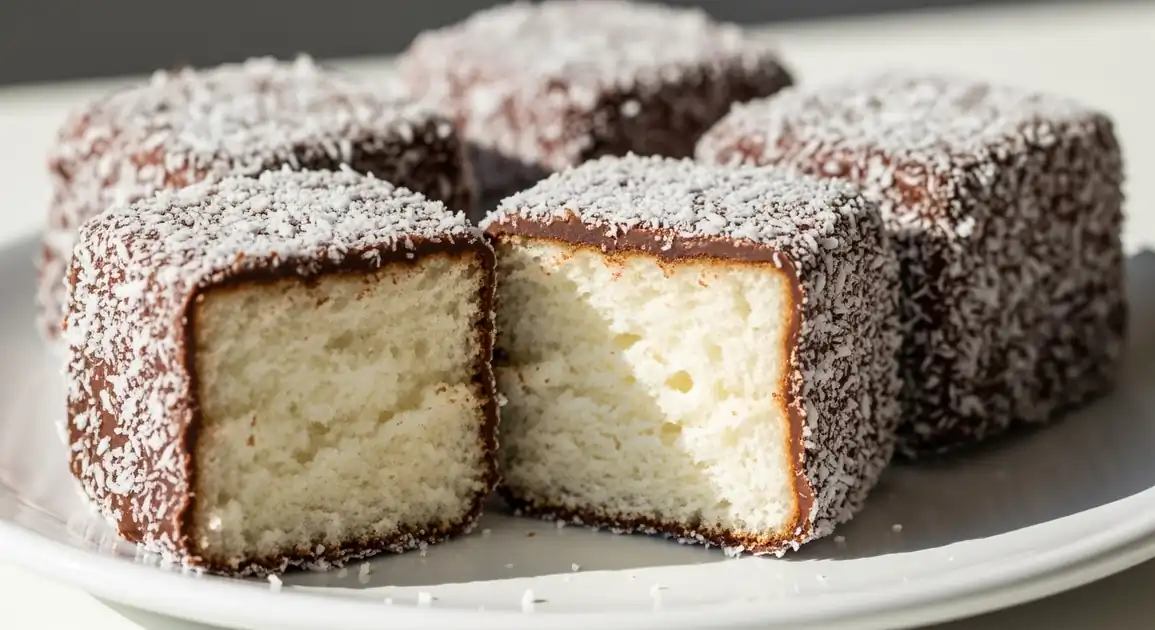Lamingtons
Lamingtons

Description
Lamingtons are ubiquitous across Australia, found everywhere from local bakeries and cafes to supermarkets and school bake sales. They are considered a national icon and are enjoyed year-round, though particularly popular around Australia Day and for community fundraising events known as 'Lamington Drives'.
Dietary Information
Serving information
Serving style
Served as individual squares or rectangles, typically on a small plate. Eaten by hand or with a cake fork. Often enjoyed with a hot beverage like tea or coffee.
Quick facts
Bakeries: Early morning (e.g., 6 AM) until late afternoon. Cafes: Morning until late afternoon. Supermarkets: Standard retail hours.
Safety Tips
What to Look For
-
Fresh appearance (soft sponge, moist coconut)
Indicates the lamington hasn't been sitting out for too long. Dryness is the main quality and potential minor safety (staleness) concern for plain versions.
-
Reputable source (busy bakery, trusted cafe, known brand)
Established vendors are more likely to follow proper hygiene and storage practices.
-
Proper storage for filled versions
Cream-filled lamingtons MUST be kept refrigerated to prevent bacterial growth. Check if they are stored in a chilled display.
-
Clean display cases and handling
Ensure the cakes are protected from contamination and handled with tongs or gloves.
What to avoid
-
Dry, crumbly looking sponge
Indicates staleness, affects quality and potentially suggests poor storage.
-
Discolored or very dry coconut coating
Suggests the lamington is not fresh.
-
Cream-filled lamingtons left at room temperature
Poses a significant food safety risk due to potential bacterial growth in the cream.
-
Cracked or weeping icing
Can indicate temperature fluctuations or staleness.
Price information
Price range
Budget tips
- Supermarket multi-packs offer the lowest price per piece, but quality may vary.
- Local bakeries often provide good value for fresh, single lamingtons.
- Cafe prices are generally higher.
- Fundraiser lamingtons are often sold in packs (e.g., half-dozen).
Value indicators
- Soft, moist sponge.
- Generous coating of coconut.
- Quality chocolate icing (not too thin or artificial tasting).
- Freshly made appearance.
Where to Find This Dish
Local Bakeries
Found in almost every suburb and town across Australia.
Main streets, Shopping strips
Morning (for freshest batch)
Supermarkets
Major chains (Woolworths, Coles, ALDI) stock packaged lamingtons in their bakery sections.
Woolworths, Coles
Store opening hours
Cafes
Commonly featured in the cake display cabinet.
Local cafes, Coffee shop chains
Cafe opening hours
Vendor Tips
- Ask your local bakery when they make their lamingtons for maximum freshness.
- For fundraisers ('Lamington Drives'), pre-ordering is often required.
- Check the 'use by' date on supermarket packs.
How to Order
Regional Variations
-
Jam Filled Lamington
(Jam Filled Lamington)
The classic lamington sliced horizontally and filled with a layer of strawberry or raspberry jam.
-
Cream Filled Lamington
(Cream Filled Lamington)
Sliced horizontally and filled with fresh whipped cream or mock cream.
-
Jam and Cream Filled Lamington
(Jam and Cream Filled Lamington)
Filled with both jam and cream, a popular indulgent variation.
-
Raspberry Lamington
(Raspberry Lamington)
Made with a pink raspberry-flavored icing instead of chocolate.
-
Mini Lamingtons
(Mini Lamingtons)
Smaller, bite-sized versions of the classic cake.
-
Lamington Fingers
(Lamington Fingers)
Rectangular shaped lamingtons, often plain.
Cultural context
History
Widely accepted as an Australian invention, the lamington is most often linked to Lord Lamington, Governor of Queensland (1896–1901). Anecdotal stories attribute its creation to his chef, Armand Galland, who perhaps needed to stretch a leftover sponge cake for unexpected guests, dipping slices in chocolate and coconut. Another story suggests it was an accident involving dropping cake into chocolate. Regardless of the exact origin, the cake quickly gained popularity and became synonymous with Australian baking, particularly for afternoon tea and fundraisers.
Local significance
Considered one of Australia's national cakes, a symbol of simple, unpretentious home baking and community spirit (fundraisers).
Eating customs
- Eaten as a snack or dessert.
- Perfect accompaniment to tea or coffee.
- Informal and widely enjoyed by all ages.